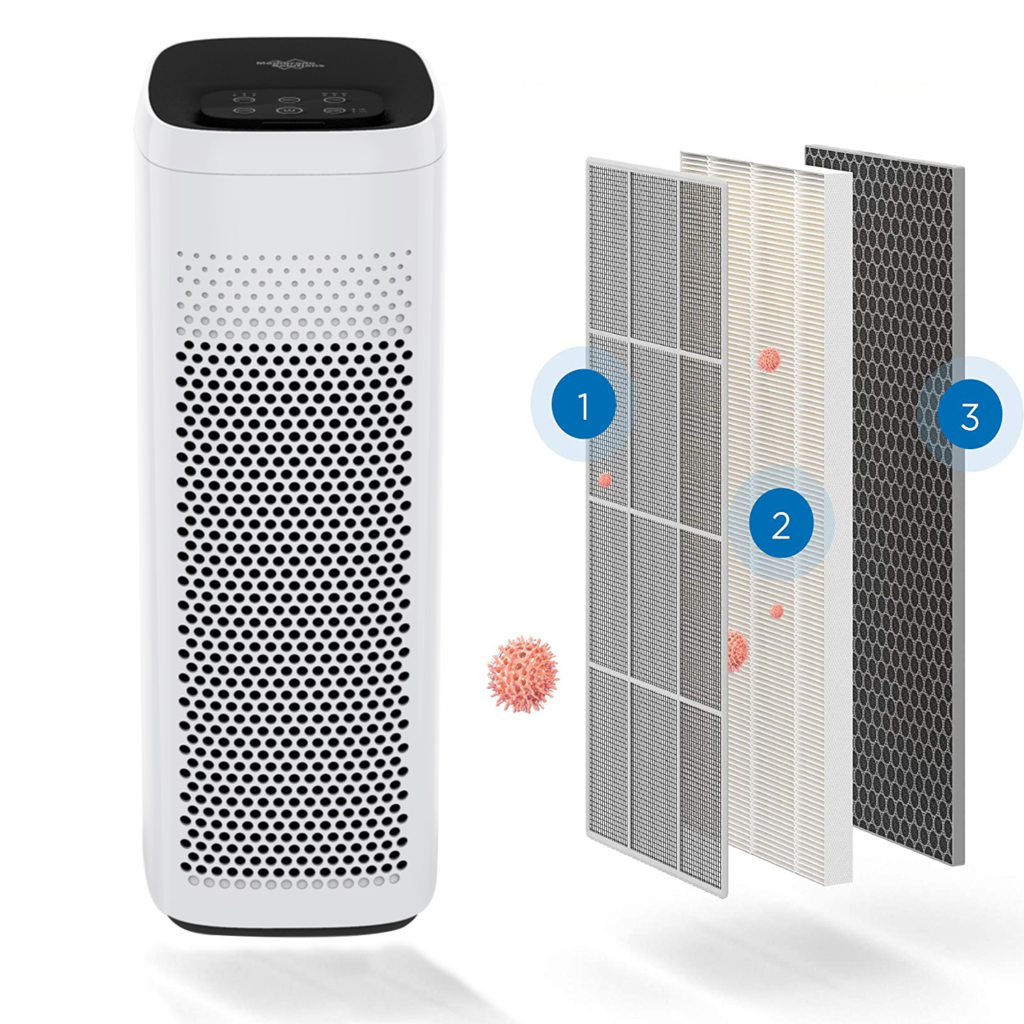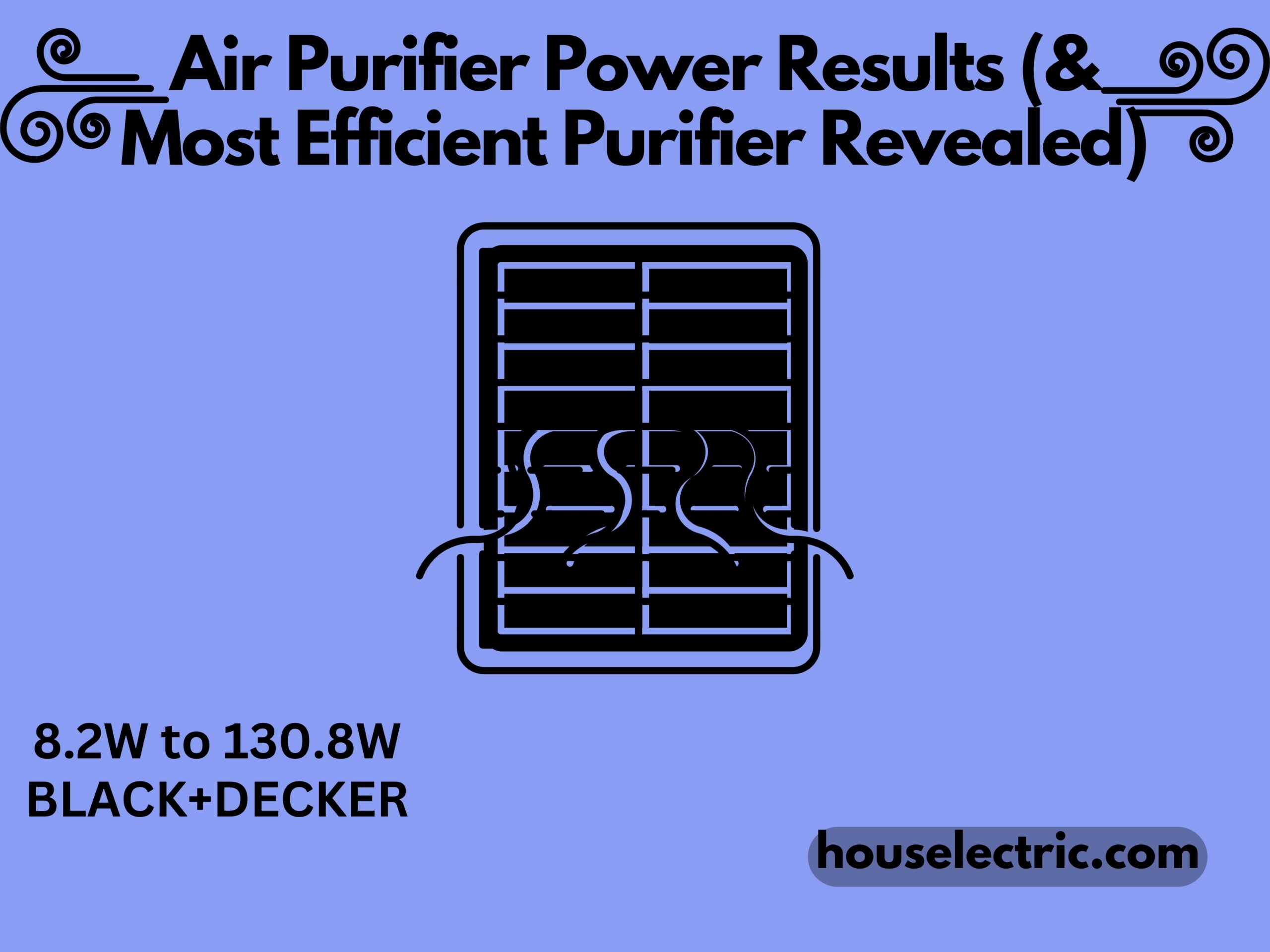A person who is reading this article is obviously that they are making up their mind to buy an air purifier or wants to get knowledge about the air purifier. The article you are going to read is based on studying 243 air purifiers. It will give information about Air purifier wattage, the most energy-efficient purifier electricity usage, and wattage.
Air purifier wattage:
On average, the air purifier uses a wattage that ranges between 8.2 Watts and 130.8 watts when they are actively used. On average, the most common age used by the air purifier is 50.2 watts. If the air purifier is in standby mode it uses a voltage between zero and 1.97 watts.

How much electricity is consumed by an air purifier?
The electricity used by an air purifier on average is 0.81 kWh per day and 29 4.93 per month. The air purifier which comes in the category of most common consumes electricity which is 0.92 kWh per day and 334.49 kWh per year. The following table explains the electricity used by the air purifier according to the duration of use:
| Consumption Category | Daily usage | Weekly usage | Monthly | Annually usage |
| Average | 0.81 kWh | 5.67 kWh | 24.58 kWh | 294.931 kWh |
| Most common | 0.92 kWh | 6.43 kWh | 27.87 kWh | 334.491 kWh |
| Highest | 2.11 kWh | 14.81 kWh | 64.16 kWh | 769.881 kWh |
| Lowest | 0.13 kWh | 0.92 kWh | 3.99 kWh | 47.90 kWh |
What is the power consumption of an air purifier in standby mode?
When an air purifier is in standby mode it consumes Electricity that ranges from 0 kWh to 0.0197 kWh. An air purifier is used for an hour and consumes approximately .0056 kWh and standby mode. The air purifier of the most common category list uses $0.00020 per hour. According to the research done on 243 air purifiers, 5.3% of the air purifiers do not consume electricity in standby mode and 94.7% of air purifiers consume electricity in standby mode. The following table describes the amount of electricity consumed by an air purifier when it is in standby mode and used for various time duration.
| Electricity consumption category | Per hour | Per day | Per week | Per month | Per year |
| Average | 0.00056 kWh | 0.014 kWh | 0.032 kWh | 0.140 kWh | 1.648 kWh |
| Most common | 0.00020 kWh | 0.005 kWh | 0.011 kWh | 0.050 kWh | 0.584 kWh |
| Highest | 0.00197 kWh | 0.047 kWh | 0.110 kWh | 0.489 kWh | 5.752 kWh |
| Lowest | 0 kWh | 0 kWh | 0 kWh | 0 kWh | 0 kWh |
What is the clean air delivery rate (CADR) of air purifiers?
Clean air delivery rate means the amount of air that is measured in cubic feet per minute that an air purifier cleans. The CADR is used to see the performance of the air purifier and is an important factor to see the purifier’s Energy Efficiency. to Check the air purifier’s energy efficiency CADR per watt is used. Air purifiers having higher CADR per watt will be more energy efficient. The clean air delivery rate of an air purifier is between 0.9 to 14.8 CADR/W. An air purifier helps to clean the smoke, dust, and Pollen particles from the air, and for cleaning these particles the CADR/W rate does vary for each.

CADR per Watt for smoke:
- An air purifier does have CADR/W to clean the air ranging from 1.9 to 14.8.
- On average an air purifier cleaning the smoke from the air rate is up to 4.4.
- The most common CADR/W for cleaning the smoke is 2.5.
- The most energy-efficient air purifier for cleaning the smoke from the air is the powermatic PM1250.
CADR per watt for dust:
- An air purifier does have CADR/w to clean the ear from dust particles ranging from 1.05 to 13.6.
- On average, an air purifier has CADR/W for cleaning the dust from the air rates up to 4.44.
- The most common air purifier shows the CADR/W for cleaning the dust is 2.59.
- The most energy-efficient air purifier for cleaning the dust from the air is the powermatic pm1250 and the air purifier with the most energy efficient for households is the Blueair-joys
CADR per Watt for pollen:
- An air purifier CADR/W rate for cleaning the Pollen from the air ranges from 0.9 to 14.71
- An air purifier does the cleaning of pollen from the air is 4.81 CADR/W.
- The most common air purifier for cleaning pollen is 4.07.
- The most energy-efficient air purifier is the powermatic PM1250 which has a CADR/W for cleaning pollen is 14.71.
Which are the most energy-efficient air purifiers?
The most energy-efficient air purifier is the air purifier which removes smoke, dust, and pollen from the air at a good rate. The energy efficiency of an air purifier depends upon the room size also. The following table explains the most energy-efficient air purifier according to the specific room size and the electricity consumption by them. to know the cost to run an air purifier click here.
| Room size | Most energy efficient overall | Electricity consumption per month |
| Less than 100 sq. ft. | BLACK+DECKER – BAPT01 | 6.84 kWh |
| 100-199 sq. ft. | Blueair – Joy S | 4.77 kWh |
| 200-299 sq. ft. | GermGuardian – AP5800 | 14.25 kWh |
| 400-499 sq. ft. | Carrier – CARRIER-18S | 12.70 kWh |
| 500-599 sq. ft. | Carrier – RMAP-XL | 18.61 kWh |
| 600+ sq. ft. | Powermatic – PM1250 | 15.02 kWh |
Conclusion:
An air purifier consumes between 47.9 kWh and 769.8 kWh per year. Before buying the air purifier the person should buy according to the room size and the clean air delivery rate per watt. On average, an air purifier ranges from 0.9 to 14.8. And the cleaning of cubic feet per minute of an air purifier is 209.4. The above article has explained in detail the air purifier power results and also according to which room size the most energy-efficient air purifier is.
FAQ’s
Can you leave an air purifier on overnight?
Yes, we can live with an air purifier overnight but it also depends upon the noise that is made by the air purifier there are some that have loud noise. The average consumption of electricity overnight will be 0.4 kWh so if the person is leaving the air purifier overnight should know that the approx cost for leaving overnight will be 6 cents.
What are energy star air purifiers?
An air purifier having an energy star label on it means that it is the most efficient air purifier in the market.
- How Many Solar Panels Do I Need For 1000 kWh? (Per Month & Day Explained) - March 29, 2023
- Mastering Your Home’s Electrical Consumption: A Guide to Wattage, Amperage, and Budget Management - March 28, 2023
- Trending Designer GFCI Cover Plates To Buy - March 27, 2023
